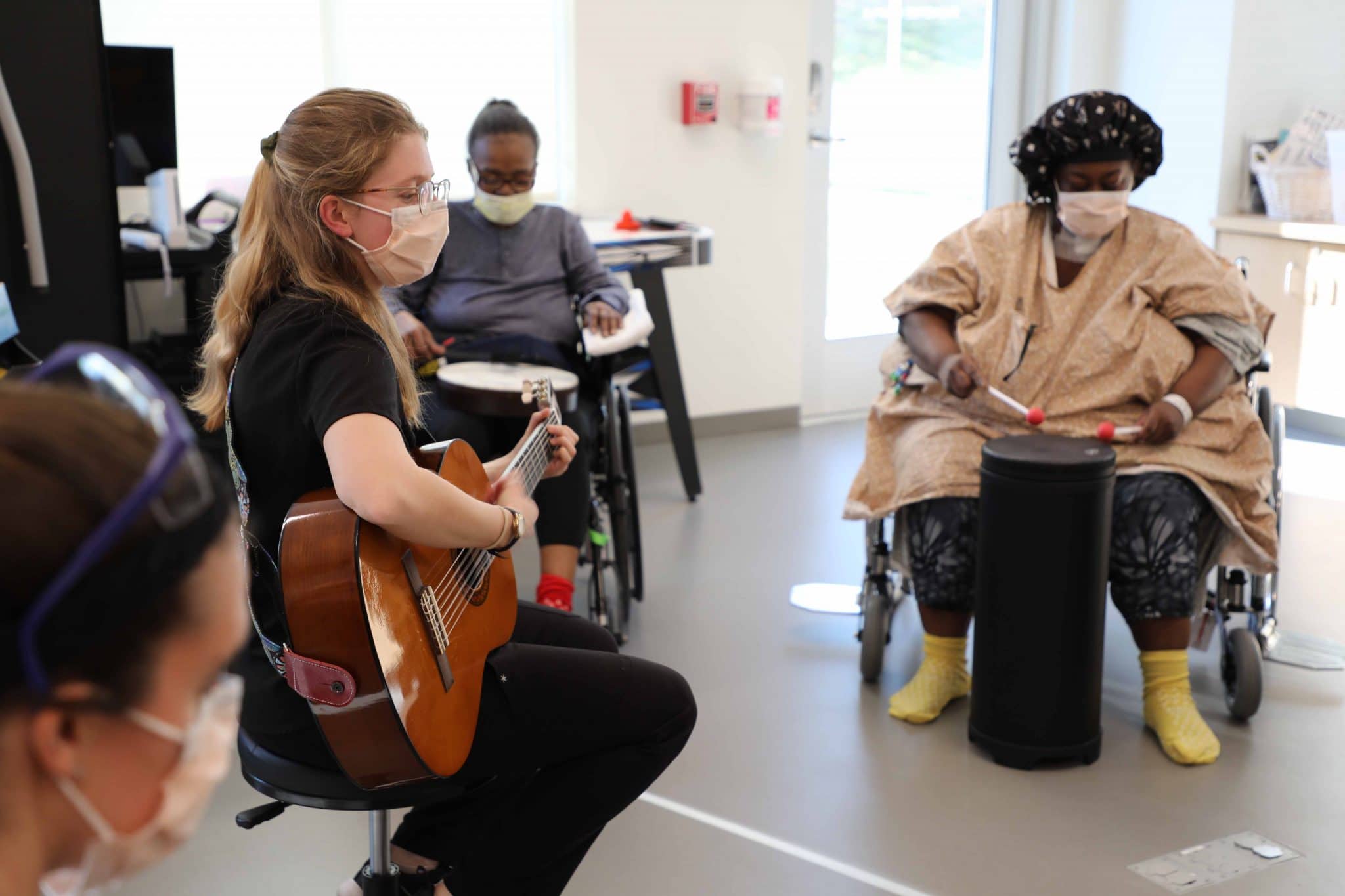Home>Events & Info>Music Therapy>Why Is Music Therapy Effective


Music Therapy
Why Is Music Therapy Effective
Published: February 2, 2024
Discover the power of music therapy and its effectiveness in promoting healing and well-being. Explore the benefits and learn why music therapy is a valuable tool for improving mental health and emotional wellness.
(Many of the links in this article redirect to a specific reviewed product. Your purchase of these products through affiliate links helps to generate commission for AudioLover.com, at no extra cost. Learn more)
Table of Contents
Introduction
Music has always held a profound impact on our emotions and well-being. It has the power to evoke memories, uplift spirits, and create a sense of calm. But did you know that music can also be used as a therapeutic tool? Music therapy is a field that harnesses the healing power of music to address various physical, emotional, cognitive, and social needs. It is an evidence-based practice that utilizes music interventions to achieve therapeutic goals.
Throughout history, music has been recognized as a powerful force in promoting healing and well-being. Ancient civilizations, such as the Egyptians and Greeks, documented the use of music in healing rituals. However, the modern practice of music therapy as we know it today emerged in the 20th century. It has since been widely recognized and integrated into various healthcare settings.
So, how does music therapy work? At its core, music therapy involves the use of music-based techniques and activities to address specific individual or group needs. These needs can range from reducing anxiety and stress to improving communication and cognitive function. Music therapists are trained professionals who use their knowledge of music and its therapeutic applications to guide clients through the therapeutic process.
One of the key benefits of music therapy is its ability to access and engage multiple areas of the brain simultaneously. When we listen to or participate in music, various regions of the brain light up and interact with one another. This unique neurological response helps to stimulate cognitive functioning, emotional expression, and sensory integration.
The benefits of music therapy are vast and wide-ranging. Research has shown that music therapy can help reduce pain, enhance mood, improve communication skills, promote physical rehabilitation, and enhance overall quality of life. It is particularly effective in treating individuals with a range of conditions, including autism spectrum disorder, Alzheimer’s disease, depression, and post-traumatic stress disorder (PTSD).
There are various techniques used in music therapy, such as songwriting, guided imagery, music-assisted relaxation, and improvisation. These techniques are tailored to the specific needs and goals of the individual or group. By creating a safe and nurturing environment, music therapists facilitate the exploration of emotions, self-expression, and the development of coping strategies.
In this article, we will explore the world of music therapy, its historical background, how it works, the benefits it offers, and its application in different populations. We will also address some criticisms and limitations to provide a comprehensive understanding of this powerful therapeutic modality. So, join us on this journey to discover how music therapy is making a difference in people’s lives.
What is Music Therapy?
Music therapy is a specialized field that uses music-based interventions to address the physical, emotional, social, and cognitive needs of individuals. It is an evidence-based practice that is conducted by trained music therapists who have extensive knowledge of music and its therapeutic applications.
Unlike simply listening to music for enjoyment or therapeutic relaxation, music therapy involves active participation in musical activities. These activities can include playing instruments, singing, composing songs, improvising, and using music as a tool for self-expression and communication.
Music therapists work with individuals of all ages and across various populations, including children with developmental disabilities, individuals with mental health conditions, patients undergoing medical treatments, and older adults in assisted living facilities. The goals of music therapy are tailored to each individual’s needs and may include improving motor skills, enhancing social interaction, managing pain and anxiety, and promoting emotional well-being.
Music therapy is based on the understanding that music has unique qualities that can impact the brain and body. Research has shown that music can elicit both physiological and emotional responses, affecting heart rate, blood pressure, and mood. It taps into neural pathways in the brain that are connected to memory, emotion, and reward, making it a powerful tool for therapy.
One of the distinguishing features of music therapy is its ability to engage multiple areas of the brain simultaneously. The act of listening to or creating music activates various parts of the brain, promoting neuroplasticity and supporting cognitive function. This is particularly beneficial for individuals with neurological conditions such as stroke or traumatic brain injury.
In addition to its cognitive and physiological benefits, music therapy can also address emotional needs. Music has the ability to evoke emotions and provide a means of expression when words may be challenging or unavailable. It can serve as a vessel for processing feelings, reducing stress, and promoting relaxation.
The effectiveness of music therapy is supported by scientific research and clinical evidence. It has been shown to have positive outcomes in various areas, including pain management, emotional regulation, communication skills, and social interaction. Music therapy is an established practice that is recognized by professional organizations, such as the American Music Therapy Association (AMTA) and the World Federation of Music Therapy (WFMT).
Overall, music therapy harnesses the power of music to facilitate healing, growth, and well-being. It offers a unique and dynamic approach to therapy that can positively impact individuals of all ages and backgrounds. Whether used as a standalone intervention or in conjunction with other therapeutic modalities, music therapy provides a rich and engaging avenue for self-expression, communication, and personal growth.
Historical Background
The use of music as a therapeutic tool has deep roots in human history. From ancient civilizations to modern times, cultures around the world have recognized the healing power of music. The practice of music therapy as a formal discipline, however, emerged in the 20th century.
Ancient societies, such as the Egyptians, Greeks, and Native Americans, documented the use of music in healing rituals. These early civilizations believed in the power of sound to restore balance and harmony within the body and spirit. Music was used to promote physical healing, alleviate emotional distress, and connect individuals to a higher spiritual realm.
In the 18th and 19th centuries, music was employed in psychiatric hospitals and asylums as a means of calming and soothing patients. However, it was not until the aftermath of World War I and World War II that the formal practice of music therapy began to take shape.
During these wars, musicians were enlisted to provide musical entertainment and solace to wounded soldiers. It was observed that music had a profound impact on the soldiers’ mood, morale, and overall well-being. This recognition led to the establishment of music therapy programs in hospitals and rehabilitation centers.
In the mid-20th century, pioneers in the field of music therapy, such as E. Thayer Gaston and Willem van de Wall, began formalizing the practice through research and clinical applications. They paved the way for the development of educational programs and the professionalization of music therapy as a distinct discipline.
By the 1960s, music therapy gained recognition as a therapeutic modality and was integrated into various healthcare settings, including psychiatric hospitals, rehabilitation centers, and schools. Organizations such as the American Music Therapy Association (AMTA) and the World Federation of Music Therapy (WFMT) were founded to promote research, education, and standards of professional practice.
Over the years, music therapy has continued to evolve and expand its reach. Advances in neuroscience have provided a greater understanding of the effects of music on the brain and how it can be utilized in therapeutic settings. This has led to the development of evidence-based interventions and the integration of music therapy into interdisciplinary treatment approaches.
Today, music therapy is practiced worldwide and is recognized as a legitimate form of therapy by healthcare professionals. It is utilized in a variety of settings, including hospitals, nursing homes, schools, and community centers. Music therapists continue to explore and innovate, finding new ways to harness the power of music to promote healing, growth, and well-being for individuals of all ages and backgrounds.
How Does Music Therapy Work?
Music therapy works through the unique and multifaceted ways in which music engages the brain, body, and emotions. It utilizes various music-based techniques and interventions to address the specific needs and goals of individuals or groups receiving therapy.
One of the primary ways in which music therapy works is through its effect on the brain. When we listen to or participate in music, multiple areas of the brain are activated and interconnected. This neurologically rich response is beneficial for individuals with neurological conditions and can promote cognitive functioning, sensory integration, and emotional expression.
The rhythmic and melodic components of music can have a profound impact on our physiology. Studies have shown that music can influence heart rate, blood pressure, and respiratory patterns. Fast, upbeat music can increase arousal and energy levels, while slow, soothing music can induce relaxation and calmness. This physiological response makes music an effective tool for managing stress, anxiety, and pain.
Another way in which music therapy works is by providing a means for emotional expression and processing. Music has the power to evoke a wide range of emotions and can serve as a vehicle for exploring and communicating feelings. When words may be difficult or inaccessible, music can provide a nonverbal outlet for self-expression and emotional release.
In addition to emotional expression, music therapy can also enhance social interaction and communication skills. Playing music together or engaging in group music-making activities fosters a sense of connection and promotes social bonding. Music therapists often use music as a medium for improving communication, turn-taking, and interpersonal skills.
Music therapy can also facilitate motor rehabilitation and improve physical coordination. Playing instruments, rhythmic movement, and dancing to music can stimulate the motor cortex and help individuals develop or regain motor skills. This is particularly beneficial for individuals with physical disabilities, motor impairments, or those undergoing rehabilitation after an injury or surgery.
The therapeutic alliance between the music therapist and the client is a critical aspect of how music therapy works. Music therapists create a safe, non-judgmental, and supportive space for clients to explore and express themselves. They adapt interventions and techniques to meet the unique needs and abilities of each individual, establishing a collaborative relationship that promotes growth and healing.
It is important to note that music therapy is not a one-size-fits-all approach. The techniques and interventions used by music therapists are tailored to the specific needs, preferences, and goals of each individual or group. Music therapists undergo extensive training and education to develop the knowledge and skills necessary to effectively use music as a therapeutic tool.
Overall, music therapy works by utilizing the inherent qualities of music to engage the brain, body, and emotions. It offers a holistic approach to therapy that can address a wide range of needs, from cognitive and physical rehabilitation to emotional expression and social connection. Through the power of music, individuals can find healing, support, and personal growth in the therapeutic process.
Benefits of Music Therapy
Music therapy offers a wide range of benefits for individuals of all ages and abilities. The therapeutic use of music has been shown to have positive effects on physical, emotional, cognitive, and social well-being. Here are some of the key benefits of music therapy:
- Emotional Well-being: Music has the power to evoke and express emotions, providing a safe outlet for individuals to process and manage their feelings. Music therapy can help reduce anxiety, stress, and depression, while promoting relaxation and a sense of well-being.
- Pain Management: Music has been found to have analgesic properties, helping to reduce pain perception and providing distraction during medical procedures or chronic pain. Listening to soothing music or engaging in music-making activities can alleviate discomfort and improve overall pain management.
- Cognitive Enhancement: Engaging in music-making activities stimulates neural connections in the brain, promoting cognitive function and enhancing memory, attention, and problem-solving skills. Music therapy can be particularly effective for individuals with neurodegenerative disorders, such as Alzheimer’s disease, in slowing down cognitive decline.
- Social Interaction: Participating in group music therapy sessions fosters social interaction, communication, and bonding. Playing music together, singing in a choir, or engaging in musical improvisation encourages collaboration, turn-taking, and listening skills, promoting a sense of belonging and connection with others.
- Physical Rehabilitation: For individuals with physical disabilities or motor impairments, music therapy can support physical rehabilitation. Playing instruments, rhythmic movement, and therapeutic exercises to music can help improve motor coordination, range of motion, and muscle strength.
- Enhanced Communication: Music therapy provides a means of communication when verbal expression may be challenging. Through music, individuals can express themselves, share their thoughts and feelings, and improve communication skills. This is particularly beneficial for individuals with autism spectrum disorder, developmental disabilities, or communication disorders.
- Stress Reduction: Listening to calming music or engaging in relaxation techniques with music can significantly reduce stress and promote a state of relaxation. Music therapy can help individuals cope with stressors, improve sleep quality, and enhance overall well-being.
- Emotional Expression: Music therapy offers a nonverbal form of emotional expression, allowing individuals to connect with and express their emotions through music. This can be particularly beneficial for those who struggle to articulate their feelings verbally or have experienced trauma.
It is important to note that the benefits of music therapy are highly individualized and can vary depending on the specific needs and goals of each person. Music therapists work closely with their clients to develop personalized treatment plans that address unique challenges and promote overall well-being.
Overall, music therapy provides a holistic approach to healing and well-being, harnessing the power of music to enhance physical, emotional, cognitive, and social functioning. Through active engagement with music, individuals can experience a wide range of benefits and find support, growth, and joy in the therapeutic process.
Music Therapy Techniques
Music therapy encompasses a variety of techniques and interventions that are tailored to address the specific needs and goals of each individual or group receiving therapy. These techniques leverage the power of music to promote healing and achieve therapeutic outcomes. Here are some of the commonly used music therapy techniques:
- Music Listening: This technique involves passive listening to carefully selected music to evoke specific emotional or physiological responses. The therapist may use music with a particular tempo, rhythm, or mood to elicit relaxation, stimulation, or emotional expression.
- Songwriting: Songwriting allows individuals to express themselves through creating original songs. It can provide a creative outlet for emotional expression, self-reflection, and storytelling. The therapist guides the individual in the process of lyric writing and composing melodies that reflect personal experiences and emotions.
- Music-Assisted Relaxation: This technique combines music with relaxation exercises to promote relaxation and reduce stress. The therapist uses calming music, guided imagery, and deep breathing techniques to guide the individual into a state of deep relaxation and rejuvenation.
- Improvisation: Improvisation involves spontaneous musical creation, where individuals freely express themselves through playing instruments or vocalizing without the need for structured notation. It encourages self-expression, creativity, and exploration of emotions in a nonverbal manner.
- Movement to Music: This technique involves using music as a prompt for movement and physical expression. Individuals may engage in rhythmic exercises, dance, or use musical cues for motor coordination and rehabilitation. It promotes physical fitness, body awareness, and integration of cognitive and motor skills.
- Music-Based Guided Imagery: Guided imagery combines music with visualization exercises to create a multisensory experience. Individuals are guided to mentally create vivid images while listening to music, tapping into their imagination to explore emotions, memories, and goals.
- Musical Games: Playing musical games adds an element of fun and engagement to the therapy process. Through interactive musical activities, such as rhythmic games, instrument playing, or singing games, participants can develop social skills, turn-taking, and cooperation.
- Neurologic Music Therapy: This specialized branch of music therapy focuses on the use of specific rhythmic and melodic interventions to target specific areas of brain functioning. It is particularly effective in treating individuals with neurological conditions such as stroke, traumatic brain injury, or Parkinson’s disease.
It is important to note that each music therapy technique is adapted and tailored to best address the unique needs, preferences, and goals of each individual or group. Music therapists are trained to select and implement techniques that effectively support therapeutic outcomes based on their clinical expertise and assessment of the client’s abilities and needs.
By utilizing these techniques, music therapists create a safe and supportive space for individuals to engage with music, fostering self-expression, communication, emotional growth, and overall well-being.
Case Studies
Examining real-life case studies provides valuable insights into the effectiveness and impact of music therapy on individuals facing various challenges. Here are a few examples of case studies highlighting the positive outcomes achieved through music therapy:
- Case Study 1: Autism Spectrum Disorder (ASD)
- Case Study 2: Alzheimer’s Disease
- Case Study 3: Chronic Pain
- Case Study 4: Mental Health
- Case Study 5: Stroke Rehabilitation
A 6-year-old boy diagnosed with Autism Spectrum Disorder struggled with communication and social interaction. Through music therapy, he engaged in structured music activities that focused on imitation, turn-taking, and joint attention. Over time, he started using his voice to communicate and showed increased interest in interacting with peers during music therapy group sessions. The rhythmic and melodic elements of music facilitated his ability to synchronize his actions with others, enhancing his social skills and overall communication development.
An elderly woman in the moderate stages of Alzheimer’s disease experienced memory loss, confusion, and withdrawal. Music therapy was used to tap into her preserved memory for music. The therapist incorporated familiar songs from her youth, resulting in immediate recognition and emotional connection. The woman’s mood improved, and she became more engaged and communicative during music therapy sessions. The use of personalized playlists also provided a means of reminiscing and maintaining a sense of identity and personal history.
A middle-aged woman suffering from chronic pain due to a musculoskeletal condition struggled with anxiety and depression. Through music therapy, a personalized relaxation playlist was created to help her manage pain and reduce stress. The music, combined with deep breathing exercises and visualization techniques, brought about a sense of calm and distraction from the pain. Regular music therapy sessions helped improve her mood, coping skills, and overall well-being, allowing her to better manage her chronic pain.
A teenager with depression and self-esteem issues struggled to express emotions and engage in traditional talk therapy. Music therapy provided an alternative means of expression and emotional release. The therapist used songwriting sessions as a platform for the teenager to express their thoughts and emotions. Writing and performing original songs allowed the individual to explore their feelings in a safe and supportive environment. Through the therapeutic process, the teenager experienced increased self-confidence, improved emotional well-being, and developed healthier ways of coping with their struggles.
A middle-aged man recovering from a stroke had limited mobility and struggled with speech and language difficulties. Music therapy was incorporated into his rehabilitation program to target motor skills and speech rehabilitation. Through rhythmic drumming exercises and vocal improvisation, the man gradually regained his ability to coordinate his movements and articulate words. The rhythm and structure of music provided a framework for organizing and sequencing his motor and speech patterns, accelerating his recovery process.
These case studies highlight the diverse range of individuals who have benefited from music therapy. Whether it is improving communication skills, enhancing emotional well-being, aiding in neurological rehabilitation, or promoting social interaction, music therapy has demonstrated positive outcomes in various populations and settings.
It is important to remember that each individual’s experience and progress may vary, and music therapy is tailored to meet their specific needs and goals. These case studies provide a glimpse into the transformative power of music therapy and its potential to improve the lives of individuals facing different challenges.
Music Therapy in Different Populations
Music therapy is a versatile and adaptable form of therapy that can be utilized in various populations and settings. Here are some examples of how music therapy is used to address the specific needs of different populations:
- Children: Music therapy is highly effective for children with developmental disabilities, including autism spectrum disorder (ASD). It helps improve communication and social skills, enhance self-expression, and reduce behavioral challenges. Music therapy also benefits children with emotional and behavioral disorders by promoting emotional regulation and providing a creative outlet for self-expression and coping.
- Adults with Mental Health Conditions: Music therapy is utilized in the treatment of adults with mental health conditions such as depression, anxiety, and schizophrenia. It offers a non-threatening and accessible medium for self-expression, emotional release, and building coping skills. Music therapy interventions can help individuals process traumatic experiences, reduce symptoms, and improve overall emotional well-being.
- Older Adults: Music therapy has significant benefits for older adults, particularly those with dementia or Alzheimer’s disease. Through personalized music programs, it can evoke memories, improve mood, alleviate agitation, and enhance cognitive function. Singing, movement, and instrument playing in group settings promote social interaction, motor coordination, and emotional connection.
- Individuals with Physical Disabilities: Music therapy plays a crucial role in physical rehabilitation and improving quality of life for individuals with physical disabilities. It addresses motor coordination, range of motion, and strength through rhythmic exercises, instrument playing, and movement to music. Music therapy can also provide a sense of empowerment, self-expression, and social engagement for individuals with physical disabilities.
- Individuals with Neurological Conditions: Music therapy is beneficial for individuals with neurological conditions such as stroke, traumatic brain injury, and Parkinson’s disease. It supports motor rehabilitation, speech and language improvement, and cognitive function through rhythm-based interventions, vocal exercises, and instrument playing. Neurologic music therapy techniques are targeted to address specific neurological deficits and facilitate neuroplasticity.
- Individuals Palliative/End-of-Life Care: Music therapy is used in palliative and end-of-life care to provide comfort, emotional support, and enhance quality of life. It can alleviate pain, reduce anxiety and depression, facilitate life review, and promote emotional and spiritual well-being. Music therapy offers a means of expression, connection, and solace for individuals and their families during challenging times.
- Special Education: Music therapy is commonly integrated into special education programs to address the unique educational needs of students with disabilities. It promotes cognitive development, socialization, communication, and academic skills through structured music activities and interventions. Music therapy also aids in behavior management and enhances overall learning experiences for students with special needs.
These examples demonstrate the versatility and effectiveness of music therapy in catering to the specific needs and goals of different populations. Music therapists are trained to adapt interventions and techniques to ensure that therapy is individually tailored and responsive to the unique needs and abilities of each person.
Music therapy has a far-reaching impact, enhancing the physical, emotional, cognitive, and social well-being of individuals across various age groups and settings. By harnessing the power of music, music therapists are able to create meaningful and transformative experiences for their clients.
Criticisms and Limitations
While music therapy has demonstrated numerous benefits and positive outcomes, it is important to acknowledge some of the criticisms and limitations associated with the field. These include:
- Limited Research: Although there is a growing body of research supporting the effectiveness of music therapy, some critics argue that the field still lacks large-scale, randomized controlled trials and rigorous scientific evidence. More research is needed to further validate the efficacy of specific music therapy interventions and to understand the mechanisms of action.
- Individual Variability: The response to music therapy can vary greatly among individuals. What works well for one person may not have the same impact on another. It is essential to tailor the therapy to each individual’s needs, preferences, and abilities, which can make the evaluation of outcomes challenging.
- Subjectivity: The therapeutic effects of music can be highly subjective and dependent on personal experiences, cultural backgrounds, and musical preferences. Music therapists must carefully select and adapt interventions to ensure they resonate with each individual, which requires ongoing assessment and flexibility in treatment planning.
- Limited Accessibility: Access to music therapy services can be limited due to factors such as geographical location, financial constraints, and lack of awareness. This restricts the availability of music therapy for individuals who could potentially benefit from it, especially in underserved communities.
- Dependency on the Therapist: Music therapists play a vital role in facilitating the therapeutic process, which may make it challenging for individuals to independently continue the benefits of music therapy outside of the therapeutic setting. It is essential to develop strategies for individuals to incorporate music as a self-care tool in their daily lives.
- Ethical Considerations: Music therapists must adhere to ethical guidelines in maintaining professional boundaries and ensuring the well-being and safety of their clients. It is crucial to prioritize the client’s autonomy, confidentiality, and consent throughout the therapeutic process.
- Time and Resources: Music therapy requires dedicated time and resources, both from the client and the therapist. The availability and sustainability of music therapy services can be limited due to financial constraints, insurance coverage, and the availability of qualified music therapists.
- Complementary Approach: Music therapy is most effective when used as a part of an integrative and multidisciplinary approach to treatment. It should not be seen as a replacement for conventional therapies, but rather as a complementary intervention that can enhance therapeutic outcomes.
It is important to address and navigate these criticisms and limitations within the field of music therapy. Ongoing research, continued professional development, and collaboration with other healthcare professionals can contribute to the further advancement and integration of music therapy into evidence-based practice.
Despite these limitations, music therapy remains a valuable and powerful therapeutic modality that has provided significant benefits to countless individuals, promoting health, well-being, and personal growth.
Conclusion
Music therapy is a dynamic and versatile field that harnesses the therapeutic power of music to address a wide range of physical, emotional, cognitive, and social needs. Through evidence-based interventions and techniques, music therapy has shown positive outcomes in various populations and settings.
By engaging with music in a therapeutic context, individuals can experience numerous benefits, including improved emotional well-being, enhanced communication and social skills, reduced pain and anxiety, and increased cognitive functioning. Music therapy provides a means of expression, connection, and personal growth for individuals of all ages and abilities.
Although music therapy has its limitations and faces criticisms, ongoing research and professional development efforts are continuously expanding the field’s understanding and practice. The adaptability of music therapy allows for individualized and tailored interventions to meet the specific needs and goals of each person.
It is important to advocate for equal access to music therapy services and educate the public and healthcare professionals about its benefits. The collaboration between music therapists and other healthcare providers can further integrate music therapy into a holistic and multidisciplinary approach to care.
In conclusion, music therapy is a powerful and effective therapeutic modality with the potential to enhance the lives of individuals across various populations. Through the healing elements of music, music therapists offer support, guidance, and transformation on a personal and emotional level. Music therapy holds immense promise in promoting overall well-being, fostering self-expression, and improving quality of life.











